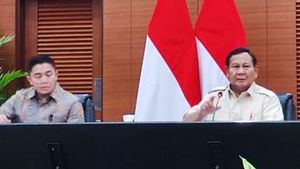JAKARTA - Executive Director of the Institute for Essential Services Reform (IESR) Fabby Tumiwa said that in starting the transition in coal energy, the central and regional governments could learn from Shanxi Province in China.
"Learning from the provinces that produce large coal, such as Shanxi in China, can inspire national and regional governments in Indonesia to imagine the transformational changes that will occur in the near future and plan the post-coal economy," Fabby said in a statement in Jakarta, quoted from Antara, Saturday, August 3.
According to him, South Sumatra and East Kalimantan, the two largest coal-producing areas in Indonesia, will be significantly affected by the global shift towards renewable energy.
The increasing international commitment to switch from fossil fuels to achieve the net zero emissions (NZE) target, including cessation of coal use and increasing the use of renewable energy, will reduce global coal demand and will ultimately reduce Indonesia's exports.
"The Indonesian government, the Provincial Governments of South Sumatra and East Kalimantan must immediately develop a comprehensive development and economic strategy to overcome the impact of the decline in coal," he said.
Strategies to prioritize sustainable alternative economic development, improve human development, innovation of renewable energy technology, processing of carbon materials without burning, and strong policy support as well as assistance to communities and affected workers must be carried out.
Shanxi Carbon-Peak-Carbon-Neutral Energy Revolution Research Institute (CCERR), in collaboration with the People of Asia for Climate Solutions (PACS), Institute for Essential Services Reform (IESR), held a Second Discussion on the Future of No Coal and a Visit to China-Indonesia Energy Transition Field from July 29 to August 1, 2024 in Shanxi Province, China.
"This visit brings together representatives from the South Sumatra and East Kalimantan governments to study the progress of the energy transition in Shanxi," explained Fabby.
He said, as China's largest coal-producing province, Shanxi has a coal reserve of 43.31 billion tons by 2022, which is 23.3 percent of China's total coal reserves.
Fabby stated that with the faster transition from coal, strategies to mitigate economic and social consequences in coal-producing areas must be a priority in the long-term and medium-term development plans at the national and regional levels.
He also suggested that the Indonesian government collaborate closely with local governments in formulating sustainable economic development plans and implement them immediately.
The government must immediately identify promising alternative economic sectors while increasing public financial literacy and preparing coal industry workers for sustainable industries.
Fabby underlined the importance of collaborating with various stakeholders at regional, national and international levels to minimize the economic and social impacts of the energy transition and facilitate knowledge exchange among coal-producing areas that are turning to clean energy.
CCERR Executive Director Zhang Cheng assessed that China and Indonesia have great potential for cooperation in the transition to renewable energy, including technology transfer, project investment, and capacity building.
"The energy cooperation between the two countries is very complementary and has wide prospects," said Cheng.
Meanwhile, PACS Executive Director Xiaojun Wang emphasized the importance of the right role of renewable energy technology in accelerating energy transitions in coal-producing areas.
According to Wang, the visit provided an opportunity for East Kalimantan and South Sumatra to see Shanxi Province's steps in developing renewable energy technology.
To strengthen energy transition knowledge in coal-producing regions, CCERR, PACS, and IESR have signed a Memorandum of Understanding (MoU) to promote the development of low-carbon energy and collaboration in energy transitions, carbon neutrality, and energy revolutions, Thursday 1 August.
SEE ALSO:
IESR Green Economy Program Manager Wira A. Swadana said that the partnership offers to share the best expertise and practice in achieving an energy future and developing a sustainable industry.
The visit of the China-Indonesia Energy Transition Field includes visits to five main locations. First, Shanxi Meijin Energy, a leading producer of independent commodity kokas with a comprehensive industrial chain that includes coal, kokas, gas, chemicals, and hydrogen.
Second, Shanxi Shuangliang Renewable Energy Industry Group, a pioneer of renewable energy technology which has 238 patents and specializes in the heat recovery of industrial waste and geothermal energy development.
Third, China Energy Engineering Group Shanxi Electric Power Construction, which focuses on planning energy and power, engineering consultation, and construction.
Fourth, the Integrated Pilot Project for Solar Power Storage, Filling and Supply of Electricity at the Dayu Toll Station and the Green Valley Carbon Neutral Environmental Science and Technology Protection Park. Fifth, the Taiyuan Design Research Institute for the Coal Industry.
The English, Chinese, Japanese, Arabic, and French versions are automatically generated by the AI. So there may still be inaccuracies in translating, please always see Indonesian as our main language. (system supported by DigitalSiber.id)










